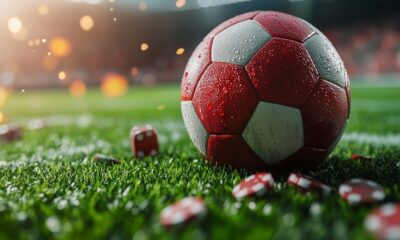Features
Easy Tips to Best Maintain Football Cleats

Soccer cleats are indispensable for enjoying a good game of football. And like sneakers, an old pair of jeans, or a favourite hat, you grow to love your football cleats. With all those games that you play in your cleats, the goals that you score, and the saves that you make…you’re bound to have fond feelings for your cleats. Cleats that have been broken into and worn for some time are comfortable to wear. Moreover, football cleats are not exactly cheap. If you don’t take care of them, even the most expensive cleats will get damaged. That’s good money down the drain, and it’s totally avoidable.
Of course, it all starts by buying quality cleats from quality brands, such as Adidas. You can attempt to maintain cheap, budget cleats all you want, but anything below $50 is bound to break down pretty quickly, no matter how clean you keep them. With footwear, you always get what you pay for. It’s really no different with soccer cleats. Save up until you can afford a good cleat in the $100-200 range. They’ll be an investment that’ll last you a good while, provided you take care of them properly.
Therefore, it’s a good idea to do what you can to maintain your cleats to extend their lifespan. Fortunately, it’s not a difficult thing to do. Do it right, and you’ll always be the one wearing the best soccer cleats on a football pitch. And when you care for your cleats, they’ll perform as they’re meant to. A stud coming loose because of worn threads or you catching a skin infection because of bacterial growth inside the cleat, are real possibilities. Fortunately, these are also entirely avoidable.
Actionable Tips to Maintain Football Cleats
- Before you get around to caring for your cleats, ensure that you’ve got the right pair for your feet. Try on the cleats to check if they’re a good fit. Cleats that are uncomfortably tight won’t become comfortable after you’ve used them a few times. Once you’ve purchased a pair, don’t wear them straightaway for a game. Get used to the feel of the studs and the weight of the cleats. Let the cleats adjust to the shape of your feet.
- Cleaning the cleats after a game is important. Use a brush with stiff bristles to loosen and pry out dirt, twigs, and pebbles too. Use a wet cloth to wipe the cleats to remove dried dirt and soil. If required, dip the cloth in a mild detergent to clean the cleats. Then wipe clean with plain water. Do not dip your leather cleats in water. Cleats, wet with water and perspiration, must be dried. This is easily accomplished by letting them dry, preferably in the well-ventilated shaded spot. Do not place your cleats in the sun or near a fire as that will make the leather shrink and the body may develop cracks, which you would then have to repair. Stuff paper inside the cleats to absorb wetness and also to prevent shrinkage. Once the cleats are dry, unscrew the studs, if they are removable, and clean the threads off any grime and dirt. Lubricate the threads with oil to ensure smooth tightening of the studs and to prevent rusting.
- Wash the shoelaces if you’ve played on a particularly muddy pitch. Clean the eyelets through which the laces pass.
- The studs on soccer cleats are meant for use on the field or artificial turf. Walking on pavements or sidewalks wearing studded cleats will wear them out quickly. Wear sneakers to the football ground and change into cleats for the game after you’re on the playing field. When removing the shoes, always do so after untying the laces. Don’t pull these off with the laces still tied. It will stretch the leather in ways it is not supposed to be stretched. Basically, if there’s any common- sense due diligence that you must apply to using your soccer cleats, then do that.
- Apply leather-nourishing polish on the cleats and let it remain for at least twelve hours before wiping the cleats with a soft cloth. But practice this in moderation. Applying too much leather cream or oil may soften the leather more than you want it to, and in time it won’t be able to take the wear and tear of a rough game of football. You want the leather to retain its ruggedness. The leather oil performs another useful function. It helps drive away odor and prevents bacterial growth in the cleats.
- Store your cleats away from direct sunlight. Ideally, the leather should have a chance to breathe. Cleats kept wrapped in plastic bags can become moldy because of the moisture that is generated. If you must keep them in a bag, use a breathable bag.
- If you can, then keep two pairs of cleats at home. This will let you use your more comfortable cleats for the important games. Also, it gives them a chance to dry naturally without you having to dry them by keeping them exposed to the elements. It’s common sense that if rotating your cleats will make both pairs last longer.
As you can see, taking care of your soccer cleats is not difficult at all. All you need to do is to create some easily cultivated habits to use the cleats in the right way and then to clean them after each use. To clean the cleats, you don’t need much more than a damp rag and some machine oil to keep the studs clean and shiny.
Taking good care of cleats not only extends their useful lifespan, but also helps you to play better. Soccer players prefer leather cleats because these cleats are comfortable and adapt to the contours of the player’s foot. Comfortable cleats can be the difference between a free kick that swerves to find the back of the net and one that sails over. Also, when you get into the habit of taking care of your cleats, you develop an attitude that will stand you in good stead as you progress ahead through the grades and levels of club football. A sportsperson who takes good care of his footwear, is respected by his peers. Do you know that this personal attribute can actually impress a scout checking out talent in schools? Your habit of taking proper care of your cleats could even land you a deal with your favorite local club!





















